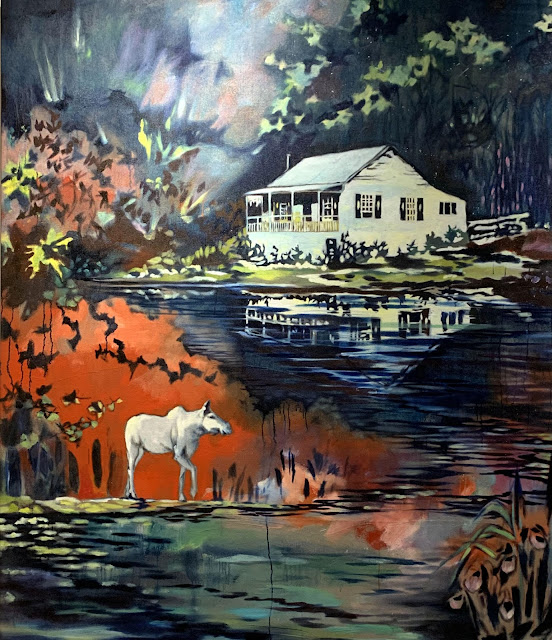 |
| Spring Bay, Mennonite Barn, oil on canvas, 2020 by Anong Beam |
Looking at my life, and with my mother entering Alzheimer's' I have been painting memories.
My practice has always centered around water and how it holds and contains us, and is a silent witness again and again to all events, constantly renewed and present in us, as it was for our ancestors.
 |
| Ghost Moose and Camp, oil on canvas, 2019 by Anong Beam |
But now I am looking back and I feel like I am reclaiming histories for myself.
I am inspired by other histories of place like Camp Forestia by Peter Doig. It is a classic camp from the Ontario north, there are many all around me, and they are completely other.
I have memories of seeing people go to them. They are the settler camps, even though they are so familiar.
They are a visual image of privilege and isolation.
 |
| Camp Cadillac oil on canvas 2018 by Anong Beam |
All around my home, even on reserve, the waterfront belongs through long term lease to non-native families, who have held them for years. These paintings are emerging to reclaim images of where I live, and to relate them back to me. It's strange to live somewhere and be of a place so fundamentally, but seeing it depicted only in a way that isolates my culture.
 |
| Mountain Lake oil on canvas 2018 by Anong Beam |
It is this medium and genre of oil on canvas.
Sections of Tom Thomson's West Wind, and his Jack Pine, appear with Doig's Camp Forestia, alongside a ghost moose, myself swimming in the lake, my boat in Swallow Lake at first snow.
My father's recurring image of a rocket launch, birds and birds and birds!
An old Cadillac, fireworks, lakes, birds, bears, and the stars.
It is just immensely pleasurable to rectify this even if it is just in my paint-world.. I love these painters as well and hold them no ill will! Peter Doig, Tom Thomson, Kim Dorland, these men are painting their lives, and I am grateful to live in a time and place where I can do the same.
 |
| Beaver Dam Overflowing, oil on canvas 2018 by Anong Beam |
Also, reaching deeper into art history, I'm happy to explore painting devices from Matisse (table with pansies, the joy of life) Botticelli Birth of Venus, Rothko's colour pairings, Georgia O'Keefe's skulls, and Agnes Martin's grids which influenced my father, back into me, into dancing elk herds.
It's really something to be the child of a famous artist. It's intense, and I've seen so much of the art world that is unkind, and unhealthy. I've seen my mother's pain inside that she was not recognized like her husband.
But all that pales in the joy that I feel creating these landscapes, internal, wishful, desirous, wanton, exploding! In some real ways they are ecstatic love stories to paint.
 |
| Deluge, oil on unstretched canvas, 2019 by Anong Beam |
Being the first series where I have made all of my own oil paints, there is an incredible circuity to making paint from rocks from Bay Fine near Killarney, then painting that same scene with those rocks that are now paint!
Each image that I make I feel and I fall immersed in the history of painting, learning devices from those who have already travelled this path.
Miigwetch.
 |
| detail of Deluge by Anong Beam |
The text in this post is Anong Beam's powerful artist statement for her exhibition: Anong Migwans Beam at Campbell House. It was curated by Elka Weinstein. I saw the show in July 2022 when it travelled to Manitoulin Island and was mounted in the Ojibwe Cultural Foundation.







